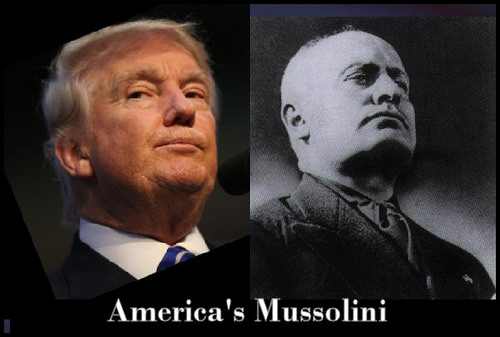21st Century Fascism: Trump Style (Part 1)
ANGLO AMERICA, 25 Jun 2018
Steven Jonas | OpEdNews – TRANSCEND Media Service
- Introduction
Just because there are elections and an elected government, don’t think that there cannot be fascism. One needs only to look at the Nazi German example. For some years before the German President Paul von Hindenburg named Adolf Hitler Chancellor (Prime Minister) of Germany on January 30, 1933, the National Socialist German Workers (Nazi) Party had simply been one of several major political parties in Germany. They usually received in the neighborhood of 1/3 of the vote in the then fairly frequent German elections. Hitler assured the aging President that despite his party’s tradition of violent rhetoric, he would rule in a Constitutional manner. And the non-Nazi Rightists, like ex-Chancellor Franz von Papen, assured Hindenburg that they would keep him “under control.” We all know what happened, beginning the very night of Hitler’s assumption of the Chancellorship with the rounding up and imprisonment without trial of Communists and Socialists. But he did come to power constitutionally. So it can happen.
(Image by Gwydion M. Williams) Permission Details DMCA
- The definition of fascism
There are a variety of them. One problem with the term is that it thrown around all too loosely, without bothering with a definition. It is even used, in the modern U.S. at least, by the Right to describe certain elements/individuals on the Left, again without bothering with a definition. In my own series of columns on the subject over time (e.g., http://www.greanvillepost.com/2015/11/11/fascism-in-the-21st-century-part-i-briefly-its-20th-century-background/ ) I have used one or another definition (and they are all similar to one another, differing only in length).
Here is one of my relatively short definitions of the term, based on the 20thcentury experience with it:
“A politico-economic system in which there is: total executive branch control of both the legislative and administrative powers of government; no independent judiciary; no Constitution that embodies the Rule of Law standing above the people who control the government; no inherent personal rights or liberties; a single national ideology that first demonizes and then criminalizes all political, religious, and ideological opposition to it; the massive and regular use of hate, fear, racial and religious prejudice, the Big Lie technique, mob psychology, mob actions and ultimately individual and collective violence, to achieve political and economic ends; a capitalist/corporate economy, with the economic ruling class’ control of State power and thus, economic, fiscal, political, and regulatory policy and policies.”
As we move into the 21st century battle against the onslaught of fascism in the United States, I think that a shorter, more succinct, but accurate definition does need to be developed. I’m working on it. In the meantime, I use the one above.
It is important to note that “a single, charismatic leader,” often used in definitions based on the Italian/German experience, is not part of the above definition. That is because while certainly those two principal fascist powers of the 20th century did have one, many of the others did not. In terms of the functions and power of the State and the ruling class it served, Japan was a fascist country. However, leader of the government during World War II, Hideki Tojo, was only the Prime Minister in a cabinet government and was not particularly charismatic for the Japanese people. Since the Japanese Emperor, the Head of State, was considered to be a god, that would have been impossible in any case. In Spain, Francisco Franco was a brutal fascist authoritarian ruler in a governmental system that met most of the elements of the definition above. But he was hardly what could have been considered charismatic.
- Fascism in the 21st Century United States: An Introduction
In times of change, fascism can be a system of government in process, not finally developed in the forms it took in 20th century. For the United States, A) under the Trumpite Republicans, a 21st century form of fascism is being developed functionally. And for them, it is the function, not the form, that counts. B) Currently, unlike the 20th century fascist states Japan and Spain, it does have a charismatic leader, charismatic for a certain segment of the population at least, as only a reality TV star can be. However, in terms of policy development and imposition, it can be seen that if the Trumpite Republicans can maintain their current control over the political organs of power, they don’t necessarily need one. In fact, the next in line for the Presidency, the Dominionist Mike Pence, while much more doctrinally sound than Trump for the Republicans, can hardly be considered to be “charismatic.”
What has to be realized is that when the fascist form of government has come into existence, it is imposed upon a country when the capitalist ruling class as a whole, or the dominant sector of it at the time of the fascist imposition, has come to the conclusion that it is necessary for it, the ruling class, to maintain power. In each of the major countries in which it arose in the 20th century, Italy, Germany, Japan, and Spain, there had been elected governments, with left-wing parties either in control of the State (Spain) or otherwise with a prominent presence in the political economy. With the exception of Spain, fascism was imposed, in the beginning, by constitutional means.
In the 21st century United States there are of course no left-wing parties participating in the electoral process. The two major parties both serve the interests of the ruling class. But they do have rather different approaches to the matter of keeping the ruling class in power. This reflects the ruling class split on the self-same issue, that has existed in this country going back to the two Roosevelts. For example, it is little known that when Teddy Roosevelt ran for the Presidency as the “Bull Moose” (3rd) Party candidate in 1912 (and received 267% of the vote), National Health Insurance was a major plank in his platform. It is also little-known that if it had not been for Watergate, the United States would have had National Health Insurance by the mid-1970s. For it was Richard Nixon who introduced such a bill to Congress in 1974, with none other than Senator Bob Dole making a brilliant introductory speech on its behalf.
But at this time, the Republican Party and the wing of the ruling class which it represents clearly see danger to their control on the horizon. The plight of the working class in this country is getting worse by the day. Trumpite mis-leading of the working class, founded as it is on racism, xenophobia, Islamophobia, and the appeal to religious authoritarianism (of which its homophobia is only one expression), can work only just so long. Already, certain elements of the white working class “Trump base” are being turned off by major elements of Trumpism, and by his increasing number of broken promises to provide long-term assistance for them. They are also alarmed by the increasing militancy of the segments of the population that are historically against Republican policy.
(Image by FolsomNatural) Permission Details DMCA
And so, in my view a 21st century form of fascism is developing in this country, under the leadership of Donald J. Trump. Since he is, to quote his Secretary of State a “moron,” and, to quote his National Security Advisor, an “idiot,” he may well be not entirely conscious of what he is doing, in terms of the political economy. (Subsequent to my original writing of this column, the journalist Michael Wolff has informed us that bunches of Trump former and present White House staff regard him in a similar light, and as functionally illiterate also. But that is another story.) But he clearly has a strong authoritarian streak within him, which, combined with the Republican policies he espouses, like the highly unpopular tax-cuts-for-the-rich, are propelling him the direction of fascism, even if he doesn’t know it, even without the installation of an actual dictatorship.
**********************
In Part 2 of this series we shall consider the elements of what can be called “21st Century Fascism in the United States.” It is historically unique because it eschews a number of the 20th century fascist forms. But the Trumpite Republicans are in the process of instituting, or would like to institute, many policies that are historically fascist, without adopting many of the fascist forms of government. Thus, functionally it can be regarded as fascist.
In Part 3 we shall present some thoughts on the problems and prospects for the Anti-Fascist movement in the U.S.
___________________________________________
Steven Jonas, MD, MPH, MS is a Professor Emeritus of Preventive Medicine at StonyBrookMedicine (NY) and author/co-author/editor/co-editor of over 35 books. In addition to his position on OpEdNews as a “Trusted Author,” he is a Senior Editor, (more…)
DISCLAIMER: The statements, views and opinions expressed in pieces republished here are solely those of the authors and do not necessarily represent those of TMS. In accordance with title 17 U.S.C. section 107, this material is distributed without profit to those who have expressed a prior interest in receiving the included information for research and educational purposes. TMS has no affiliation whatsoever with the originator of this article nor is TMS endorsed or sponsored by the originator. “GO TO ORIGINAL” links are provided as a convenience to our readers and allow for verification of authenticity. However, as originating pages are often updated by their originating host sites, the versions posted may not match the versions our readers view when clicking the “GO TO ORIGINAL” links. This site contains copyrighted material the use of which has not always been specifically authorized by the copyright owner. We are making such material available in our efforts to advance understanding of environmental, political, human rights, economic, democracy, scientific, and social justice issues, etc. We believe this constitutes a ‘fair use’ of any such copyrighted material as provided for in section 107 of the US Copyright Law. In accordance with Title 17 U.S.C. Section 107, the material on this site is distributed without profit to those who have expressed a prior interest in receiving the included information for research and educational purposes. For more information go to: http://www.law.cornell.edu/uscode/17/107.shtml. If you wish to use copyrighted material from this site for purposes of your own that go beyond ‘fair use’, you must obtain permission from the copyright owner.

